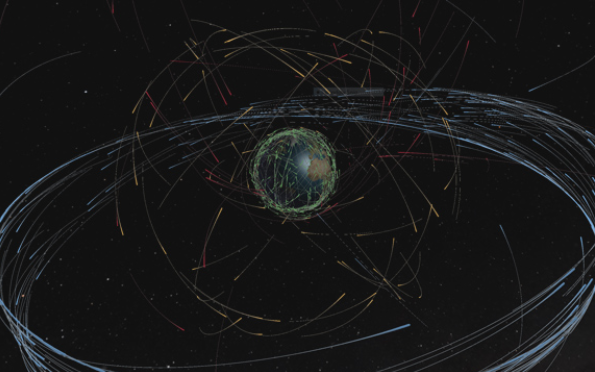What is satellite positioning like up there, is it organised or a bit chaotic?
Is there an ideal worldwide satellite positioning system ?
What is satellite positioning like up there, is it organised or a bit chaotic?
Is there an ideal worldwide satellite positioning system ?
6,000 moons
http://binsoftware.com/moons/
Highly recommended if you have access to VR.
If not, it may still be worth watching a video as the commentary alone is worthwhile in regards to your questions.
esselte said:
6,000 moons
http://binsoftware.com/moons/Highly recommended if you have access to VR.
If not, it may still be worth watching a video as the commentary alone is worthwhile in regards to your questions.
Thanks for those links.
It looks a bit chaotic, nothing like an organised turning wheel. It could be better.
Tau.Neutrino said:
It looks a bit chaotic, nothing like an organised turning wheel. It could be better.
If satellites were organised a bit better then this would help re-servicing and de-orbiting, it might also help astronomy.
Tau.Neutrino said:
Tau.Neutrino said:
It looks a bit chaotic, nothing like an organised turning wheel. It could be better.
If satellites were organised a bit better then this would help re-servicing and de-orbiting, it might also help astronomy.

Only the green ones in low Earth orbit can be reached to be serviced. Medium Earth orbit (the gold/yellow ones) and Geostationary Orbit (the blue ones) are all too far away for it to be economically or logistically viable to service them. Elliptical orbits (the red ones) come close to Earth, but are moving too quickly to be serviceable. Most astronomy satellites are in elliptical orbits as the time spent further away from Earth reduces Earth-light pollution screwing with their ability to see very faint, very distant things. Hubble is an exception, in LEO specifically because they wanted to be able to service it.
esselte said:
Tau.Neutrino said:
Tau.Neutrino said:
It looks a bit chaotic, nothing like an organised turning wheel. It could be better.
If satellites were organised a bit better then this would help re-servicing and de-orbiting, it might also help astronomy.
Only the green ones in low Earth orbit can be reached to be serviced. Medium Earth orbit (the gold/yellow ones) and Geostationary Orbit (the blue ones) are all too far away for it to be economically or logistically viable to service them. Elliptical orbits (the red ones) come close to Earth, but are moving too quickly to be serviceable. Most astronomy satellites are in elliptical orbits as the time spent further away from Earth reduces Earth-light pollution screwing with their ability to see very faint, very distant things. Hubble is an exception, in LEO specifically because they wanted to be able to service it.
ok, thanks again for that.
> Hubble is an exception, in LEO specifically because they wanted to be able to service it.
I wouldn’t go that far. Hubble was in LEO because that’s as far as the space shuttle could lift something that heavy.
It was not intended to be serviced in space, and was only judged serviceable when a service mission to another spacecraft was a success. I’m not thinking of the much earlier Skylab repair mission, that was designed to be repaired. There was an important satellite repair mission between that and the first Hubble mission.
This one: “The first orbital repair was made by James van Hoften and George Nelson in 1984 during their mission to Solar Maximum Mission (SMM) satellite”.
mollwollfumble said:
> Hubble is an exception, in LEO specifically because they wanted to be able to service it.I wouldn’t go that far. Hubble was in LEO because that’s as far as the space shuttle could lift something that heavy.
It was not intended to be serviced in space, and was only judged serviceable when a service mission to another spacecraft was a success. I’m not thinking of the much earlier Skylab repair mission, that was designed to be repaired. There was an important satellite repair mission between that and the first Hubble mission.
This one: “The first orbital repair was made by James van Hoften and George Nelson in 1984 during their mission to Solar Maximum Mission (SMM) satellite”.
Ummm. Really?
“Servicing missions and new instruments
Hubble was designed to accommodate regular servicing and equipment upgrades while in orbit. Instruments and limited life items were designed as orbital replacement units. Five servicing missions (SM 1, 2, 3A, 3B, and 4) were flown by NASA space shuttles, the first in December 1993 and the last in May 2009.”
According to Wikipedia.
https://en.wikipedia.org/wiki/Hubble_Space_Telescope#Servicing_missions_and_new_instruments